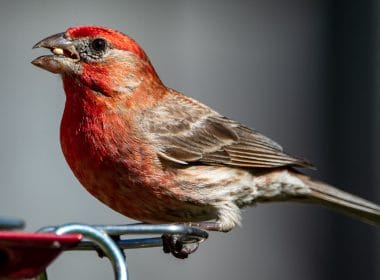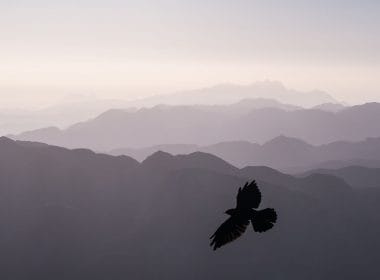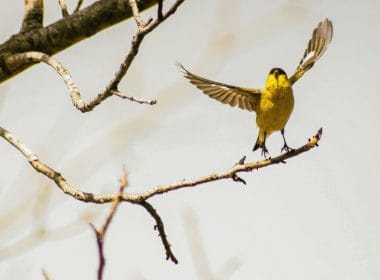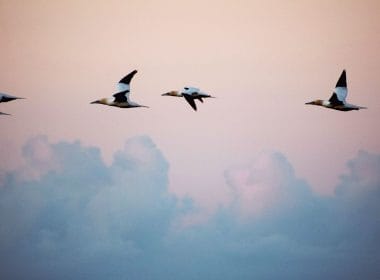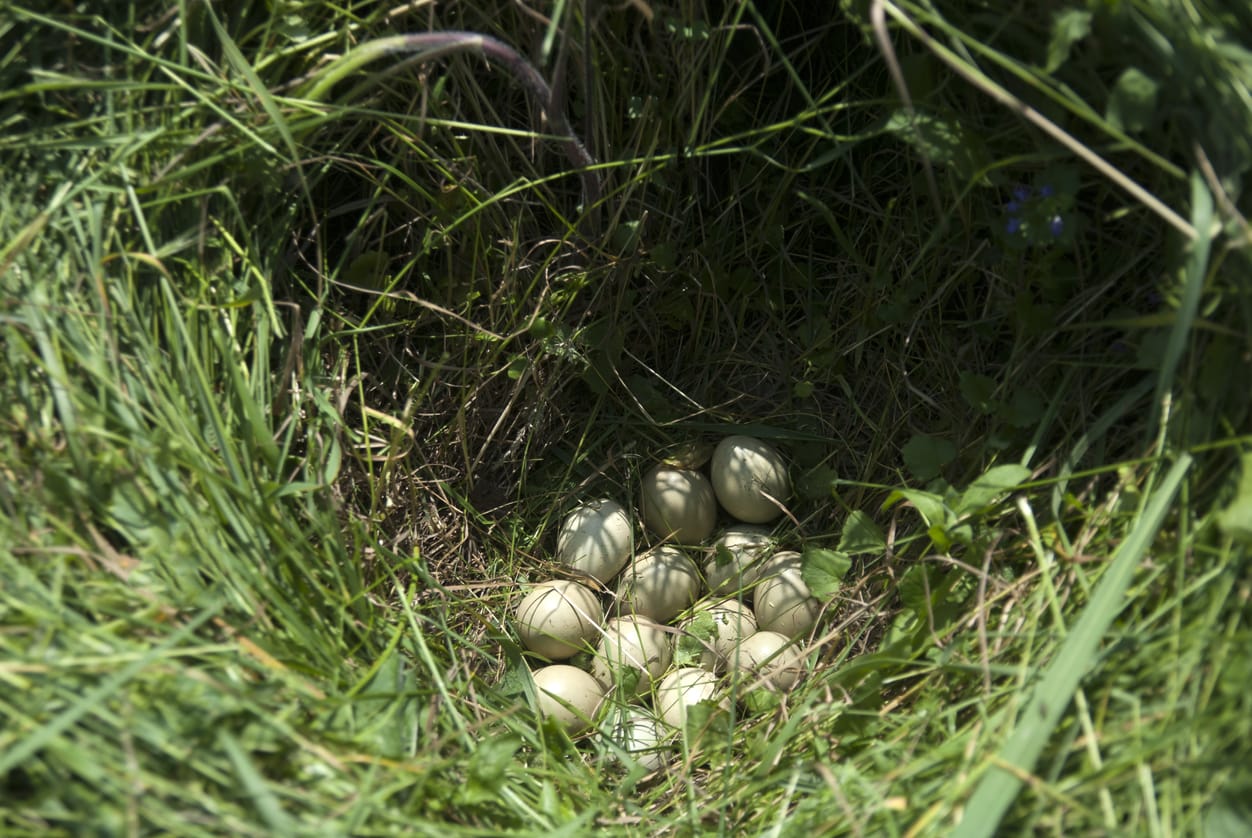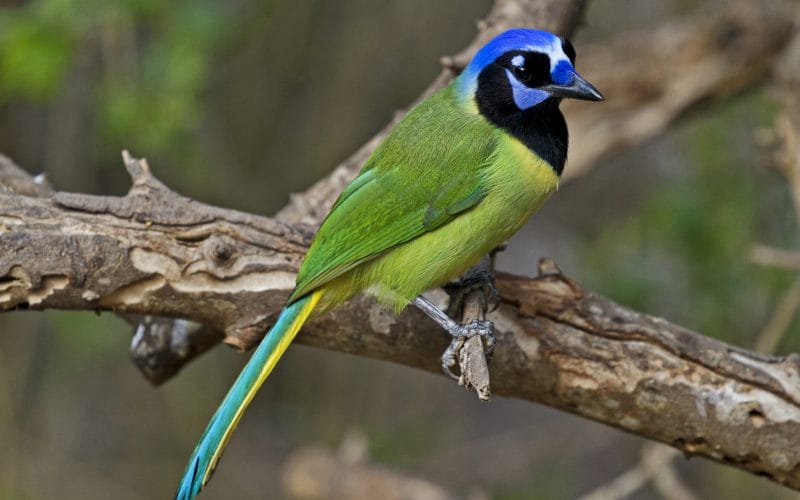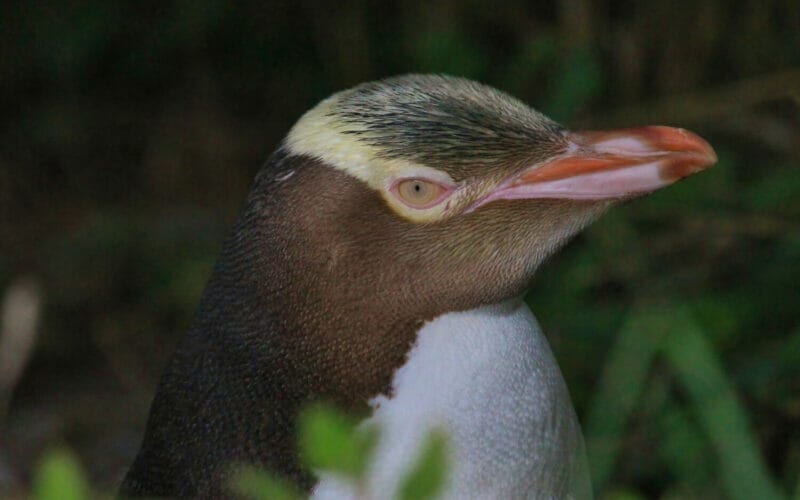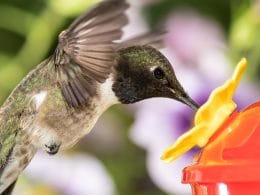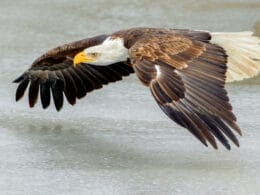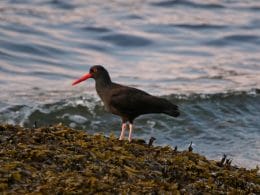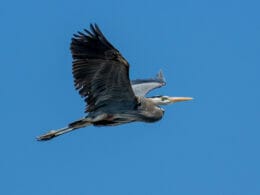Did you know that many birds nest on the ground? That’s right! Most people believe that birds build their nests on trees only, but that’s not true.
Birds can nest in a variety of locations from rocky mountains to wet marshes. Today, we’re taking a closer look at 19 different species of birds that make nests on the ground from 7 bird types.
Top 19 Birds That Make Nests on the Ground
Shorebirds
Shorebirds include avocets, terns, puffins, gulls, stilts, sandpipers, plovers, and penguins. Here are a few examples:
1. Atlantic puffin
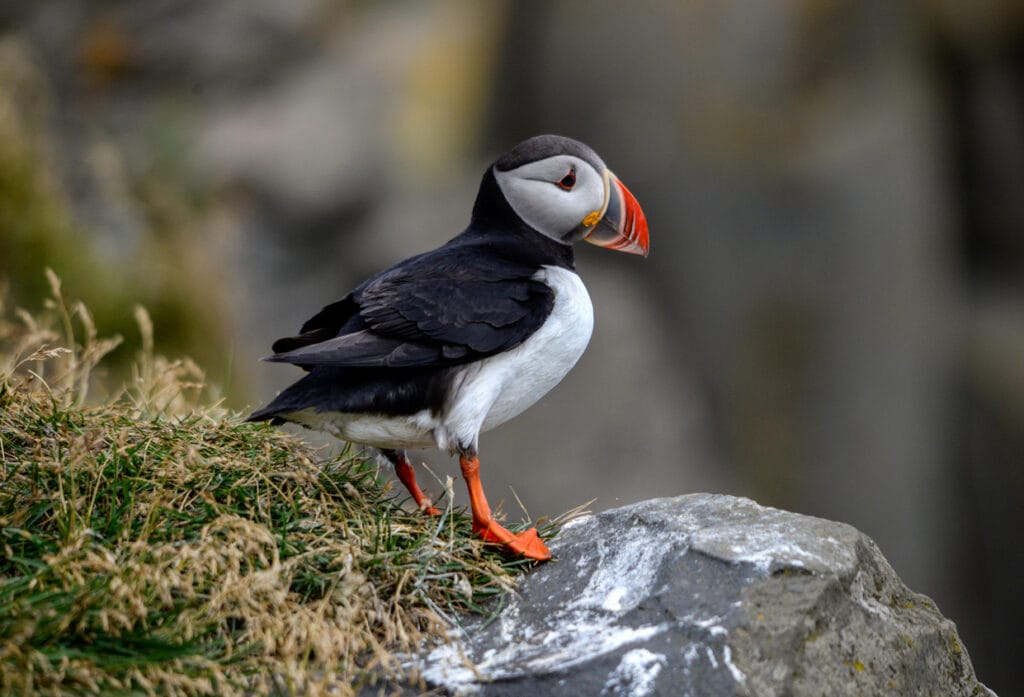
- Scientific name: Fratercula arctica
- Length: 10.2 to 11.4 inches
- Wingspan: 20.9 inches
- Weight: 10.9 to 19.4 ounces
Atlantic Puffins are black on top with white undersides. Their beaks are black, white, orange, and yellow during breeding with a pale gray face.
Author Note: Outside of the breeding season, their beaks lose the orange/yellow marks and their face becomes a dark gray.
The official bird of Newfoundland and Labrador, Canada, the Atlantic Puffins nest in burrows or shallow holes in the ground. In rocky spots, they nest within crevices of rocks or under boulders.
2. California Gull
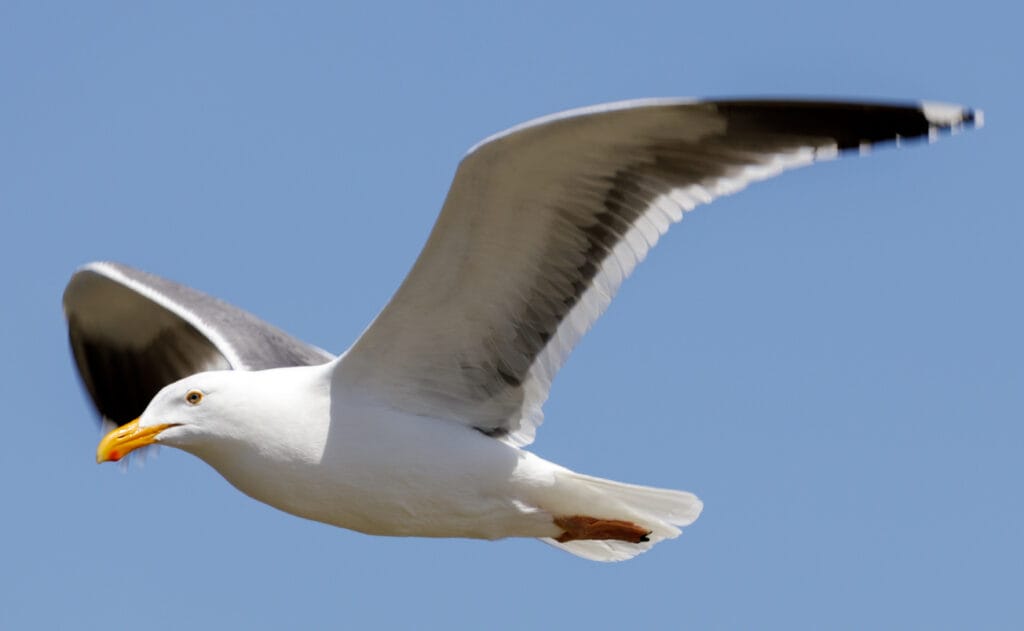
- Scientific name: Larus californicus
- Length: 18.5 to 21.3 inches
- Wingspan: 51.2 inches
- Weight: 15.2 to 36.9 ounces
With a medium-sized body and a slim beak compared to other species of gulls, adult California Gulls possess gray backs, pitch-black eyes, yellow beaks with a black ring at the tip, and yellow legs.
During the breeding season, their heads are completely white and the red mark on the lower mandible is a lot brighter. When nonbreeding, brown patches appear on their heads.
California Gulls nest on the ground either out in the open or at the base of small trees. On average, these nests are 11 inches wide and take about 7 days to finish.
3. American Avocet
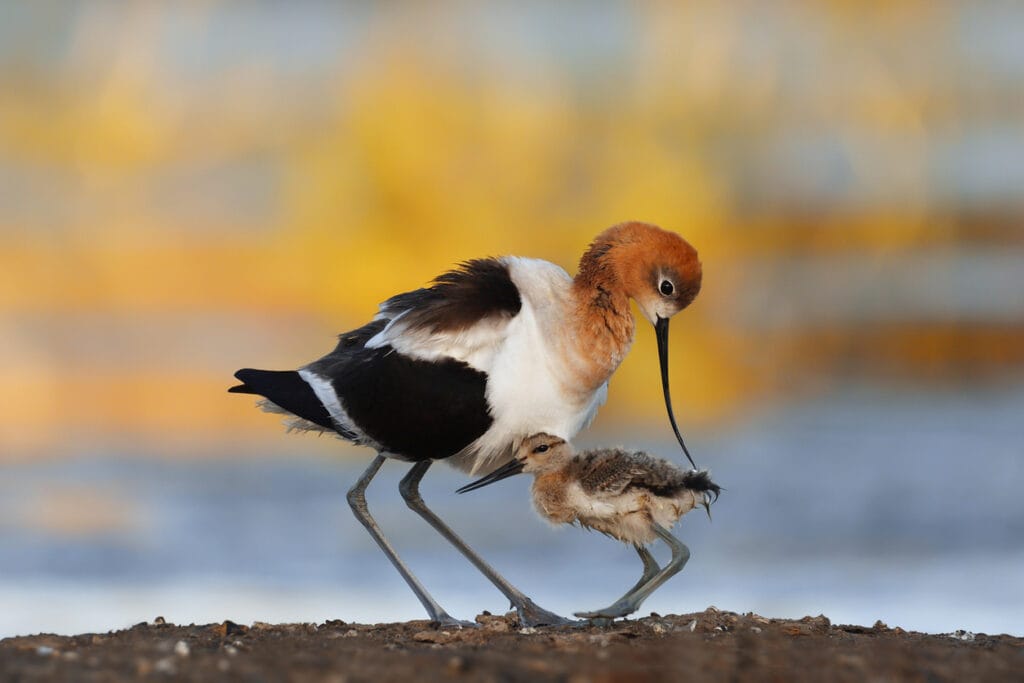
- Scientific name: Recurvirostra americana
- Length: 16.9 to 18.5 inches
- Wingspan: 28.4 inches
- Weight: 9.7 to 12.3 ounces
American Avocets possess mostly white bodies with black and white wings. Their backs show two black bands and their legs are a blue-gray shade.
During the breeding season, their heads and necks turn a rusty orange color. After breeding, they become pale gray.
A couple of American Avocets will choose a very slight dip in the ground to create their nest. Then, they’ll either leave it like that or line it with some grass, pebbles, or feathers.
Game Birds
Game birds include oystercatchers, turkeys, quails, grouses, partridges, pheasants, and guineafowl. Here are a few examples:
4. American Oystercatcher
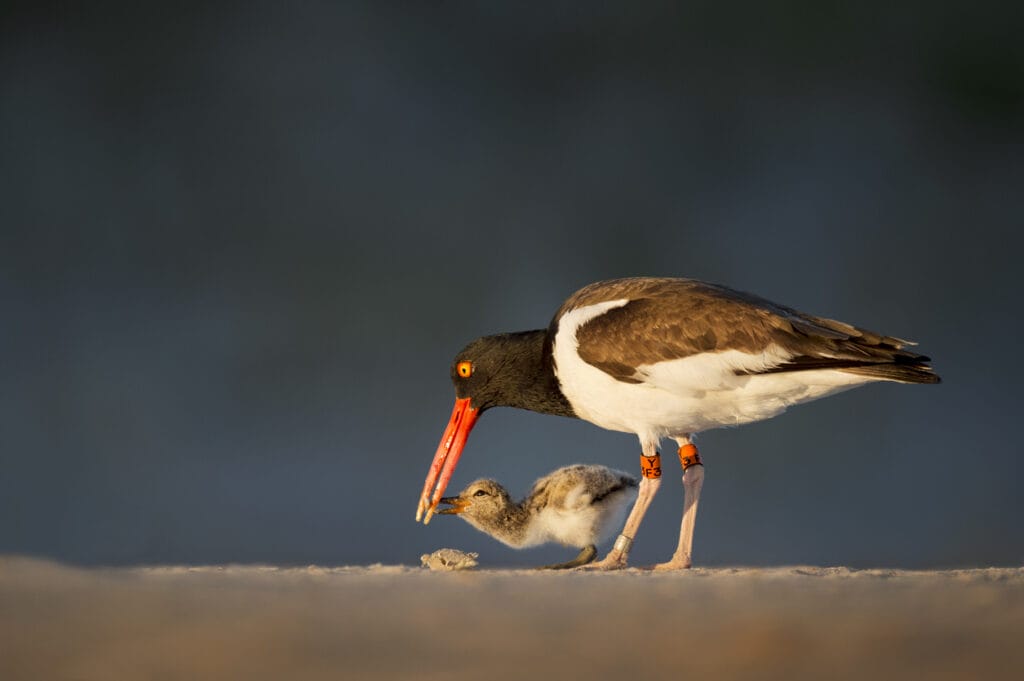
- Scientific name: Haematopus palliatus
- Length: 15.8 to 17.3 inches
- Wingspan: 32 inches
- Weight: 14.1 to 24.7 ounces
If you look at an American Oystercatcher up close, you’ll see that it has a brown back and wings, a white underside, a black breast, and a dark head.
Author Note: American Oystercatchers also possess a bright orange-red beak and yellow eyes surrounded by red rings. Their nests are nothing but lining-less depressions in the sand across barrier beaches, high marshes, and shelly islands.
5. Wild Turkey
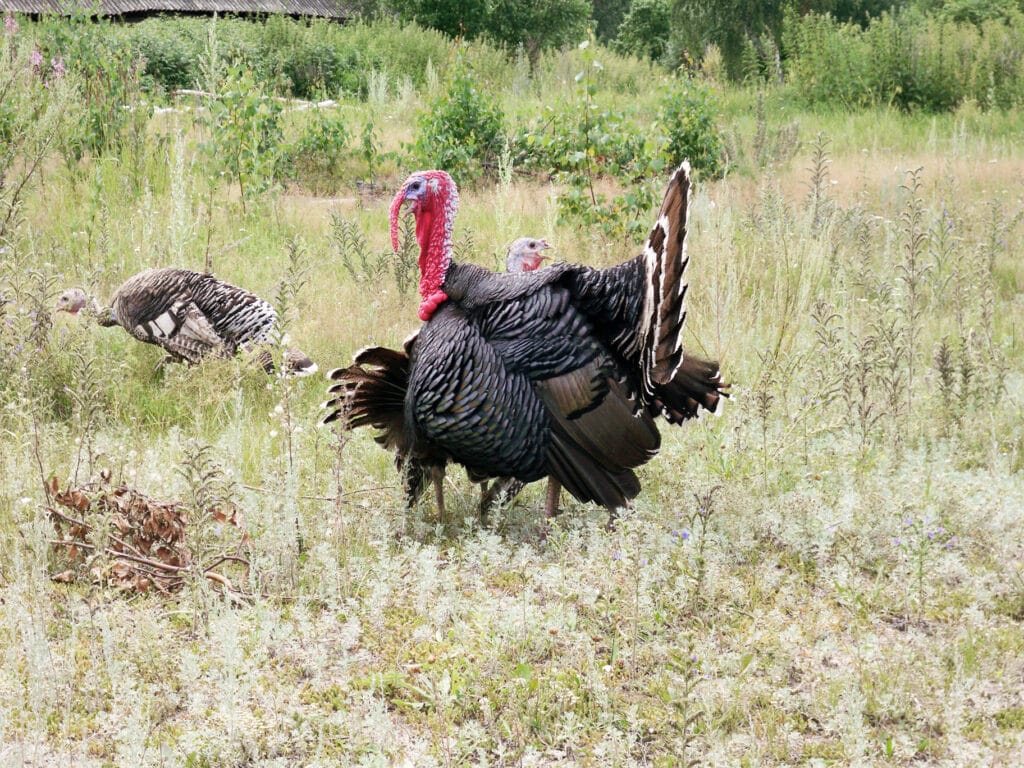
- Scientific name: Meleagris gallopavo
- Length: 43.3 to 45.3 inches
- Wingspan: 49.2 to 56.7 inches
- Weight: 88.2 to 381.0 ounces
One of the biggest and heaviest birds in the country, this turkey usually builds its nest beneath thick vegetation, beneath brush piles, or at tree bases. Sometimes, it’ll choose to nest in an open field instead.
Wild Turkeys dig a shallow 1-inch dip in the sand or soil, then line it with dead twigs, leaves, and other plant materials found in the area. Their nests are typically between 9 and 13 inches long and up to 11 inches wide.
6. Ring-necked Pheasant
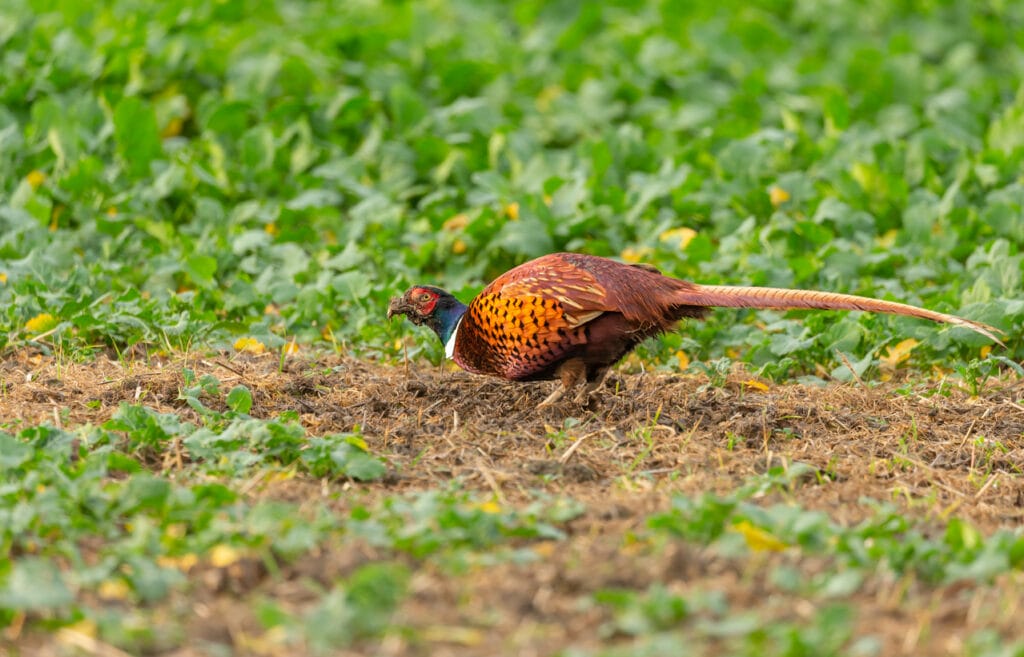
- Scientific name: Phasianus colchicus
- Length: 19.7 to 27.6 inches
- Wingspan: 22.1 to 33.9 inches
- Weight: 17.6 to 105.8 ounces
Male Ring-necked Pheasants are quite flashy with particularly long tails. They possess iridescent green-blue necks with a thick white ring at the base and bright red faces.
To build their nests, the female chooses a suitable spot on the ground with tall vegetation surrounding it. It’s usually a natural dip that the female further digs to become as deep as 3 inches and lines using leaves, feathers, and/or twigs.
Waterfowl
Waterfowl include swans, ducks, and geese. Here are a few examples:
7. American Black Duck
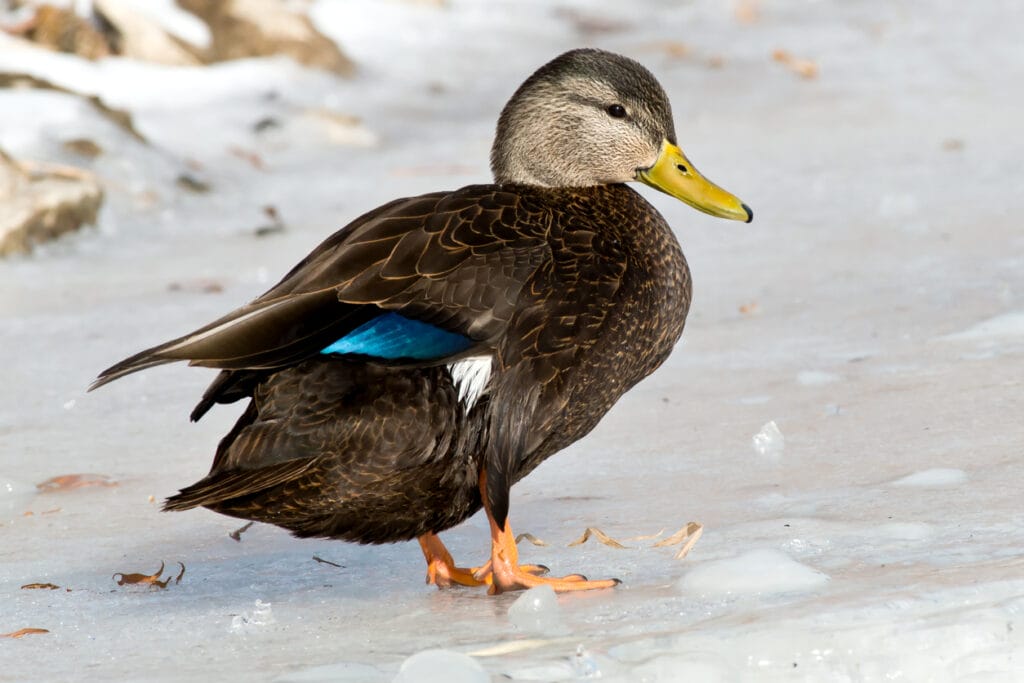
- Scientific name: Anas rubripes
- Length: 21.3 to 23.2 inches
- Wingspan: 34.6 to 37.4 inches
- Weight: 25.4 to 57.9 ounces
For the American Black Duck, it’s the female that chooses the nesting site. It’s typically a well-hidden spot on marshes, grassy islands, croplands, or uplands.
It may also pick a crevice among rocks or a place under brush piles, in a shrubby location, or a hay bale. The nest is an average of 1.5 inches deep and 7 to 8 inches wide.
8. Cackling Goose
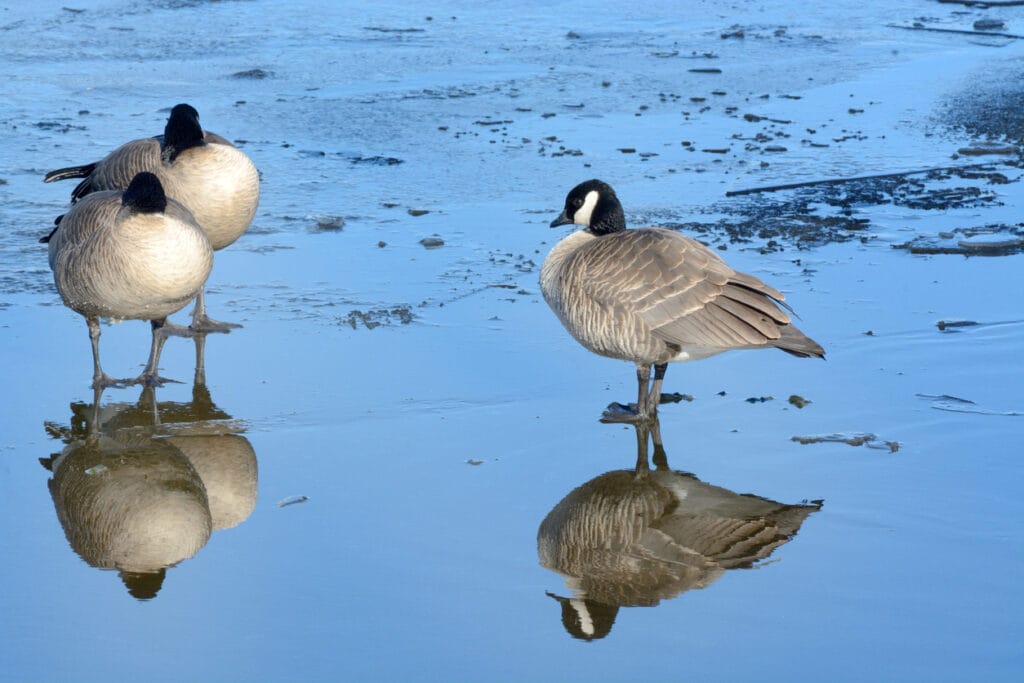
- Scientific name: Branta hutchinsii
- Length: 24.8 to 25.6 inches
- Wingspan: 42.5 to 43.7 inches
- Weight: 49.3 to 84.0 ounces
The Cackling Goose has a black head, beak, and tail. Its neck is black with a white ring at the base and its legs and feet are black. The rest of its body is shades of brown with white under the tail.
Author Note: Once the female chooses the nest location on the ground, it scrapes to make a hole and then uses leaves, grasses, mosses, and twigs to give it shape. She lines the nest with feathers to receive the eggs.
9. Trumpeter Swan
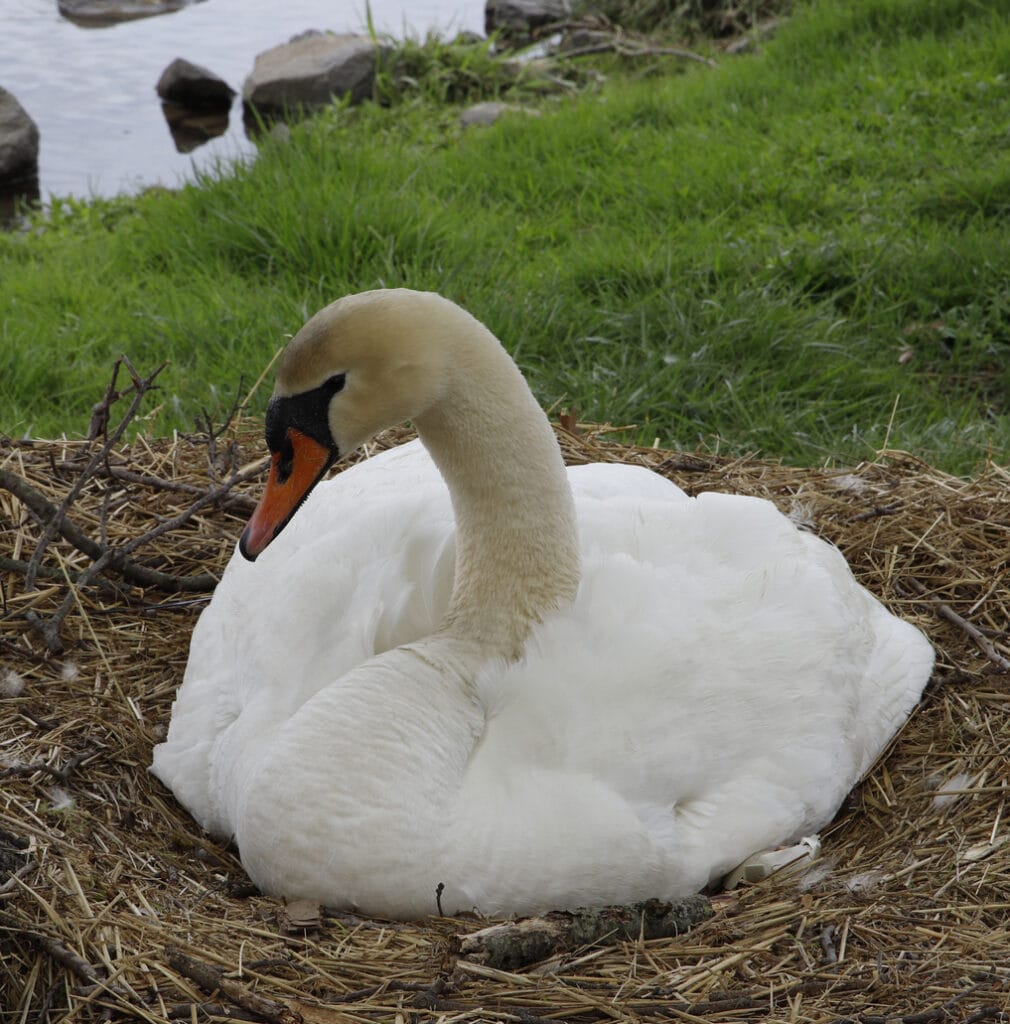
- Scientific name: Cygnus buccinator
- Length: 54.3 to 62.2 inches
- Wingspan: 79.9 inches
- Weight: 271.6 to 448.0 ounces
The largest native waterfowl in North America, the Trumpeter Swan is all white except for its black beak and black legs.
Both sexes of the Trumpeter Swans share nest-building duties. They choose a spot that’s no farther from shore than 600 feet, usually located on beaver dams, small islands, floating vegetation, or manmade structures.
Their nests take an average of 25 days to finish, measuring around 4 to 8 inches deep and 10 to 16 inches wide.
Wading Birds
Flamingos, ibises, rails, cranes, storks, and herons are classified as wading birds. Here are a few examples:
10. Glossy Ibis
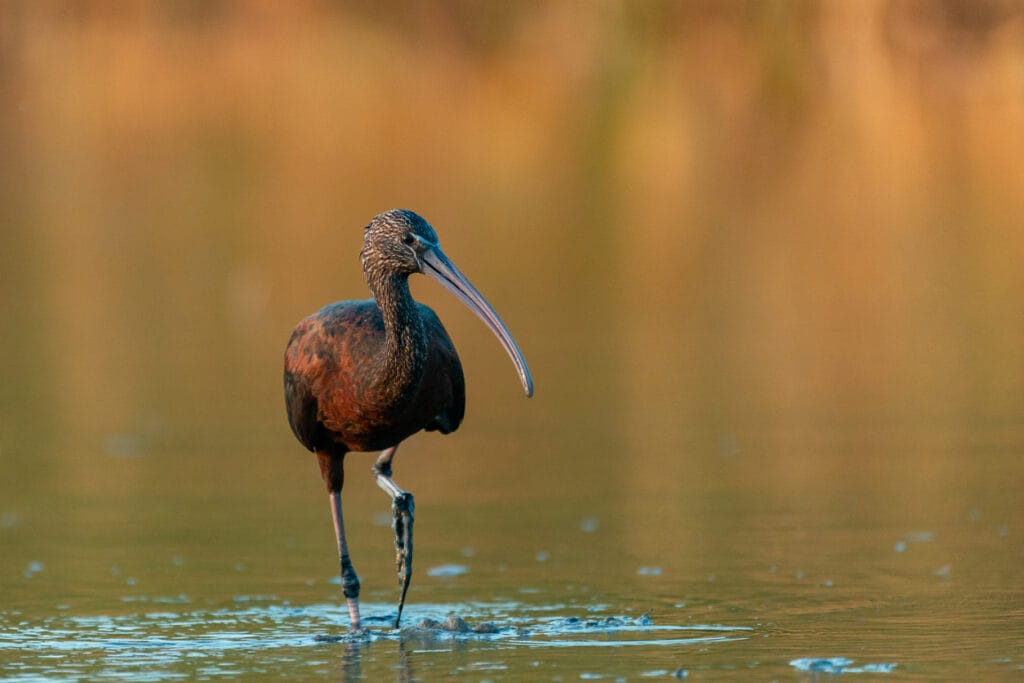
- Scientific name: Plegadis falcinellus
- Length: 18.9 to 26.0 inches
- Wingspan: 31 to 41 inches
- Weight: 18.7 to 27.1 ounces
With a long neck and a long down-curved beak, the Glossy Ibis has a maroon plumage with metallic bronze, green, and purple hues on its wings.
Both sexes of this species cooperate to build a bulky nest, made from the vegetation available in the area such as reeds, twigs, or sticks. The nest can be up to 1 foot wide and 1 foot deep.
11. Sandhill Crane
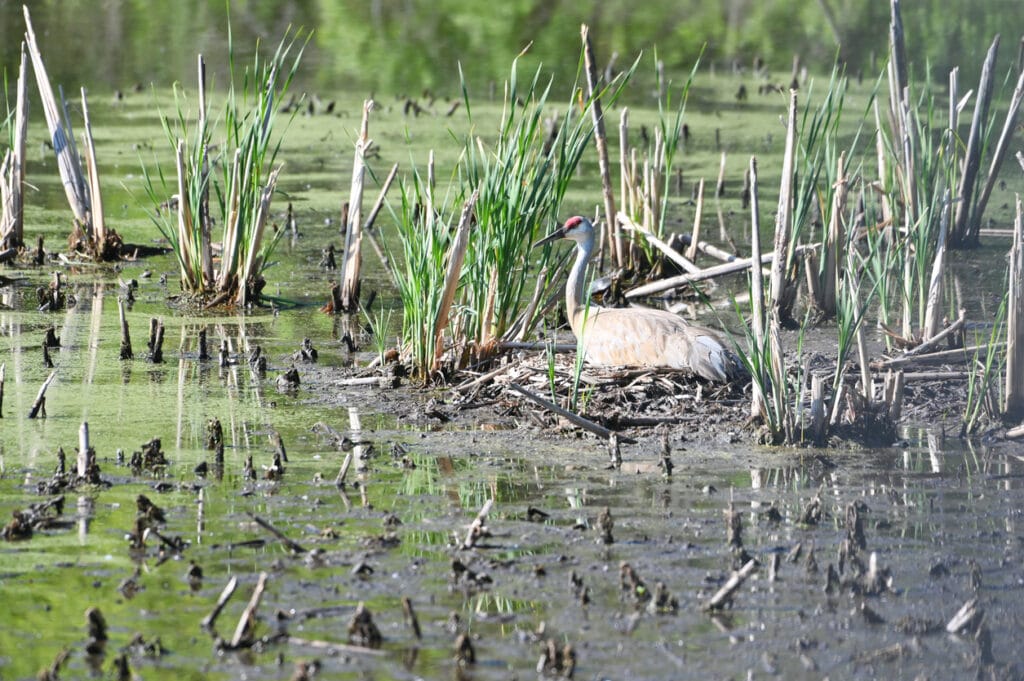
- Scientific name: Antigone canadensis
- Length: 47.2 inches
- Wingspan: 78.7 inches
- Weight: 119.9 to 172.8 ounces
Sandhill Cranes are mostly pale gray with black beaks and legs. They possess a unique red patch on their crown.
These birds like to nest in small wetlands or at a maximum distance of about 900 feet from the outline of bigger ones. Whatever the available vegetation is, they’ll use it to make their nests until about 30 to 40 inches wide.
12. Black Rail
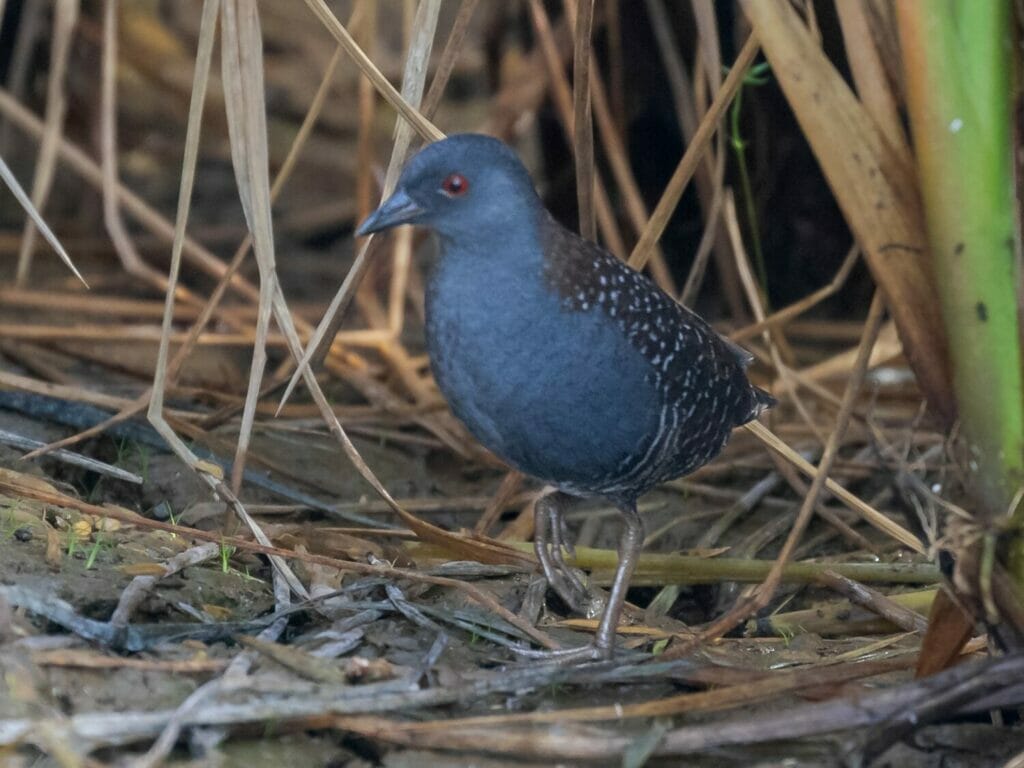
- Scientific name: Laterallus jamaicensis
- Length: 3.9 to 5.9 inches
- Wingspan: 8.7 to 11.0 inches
- Weight: 1.0 to 1.2 ounces
Black Rails possess a dark plumage with white spots above. Their beaks are also black but their eyes are red and their legs are a pink-wine color.
Top Tip: Both males and females choose the nesting location, usually in a marsh and hidden dead or living vegetation. They make their nest into a circular shape that measures 1.7 inches deep and 5 inches wide.
Songbirds
Songbirds that nest on the ground include thrushes, larks, and bobolinks. Here are a few examples:
13. Hermit Thrush
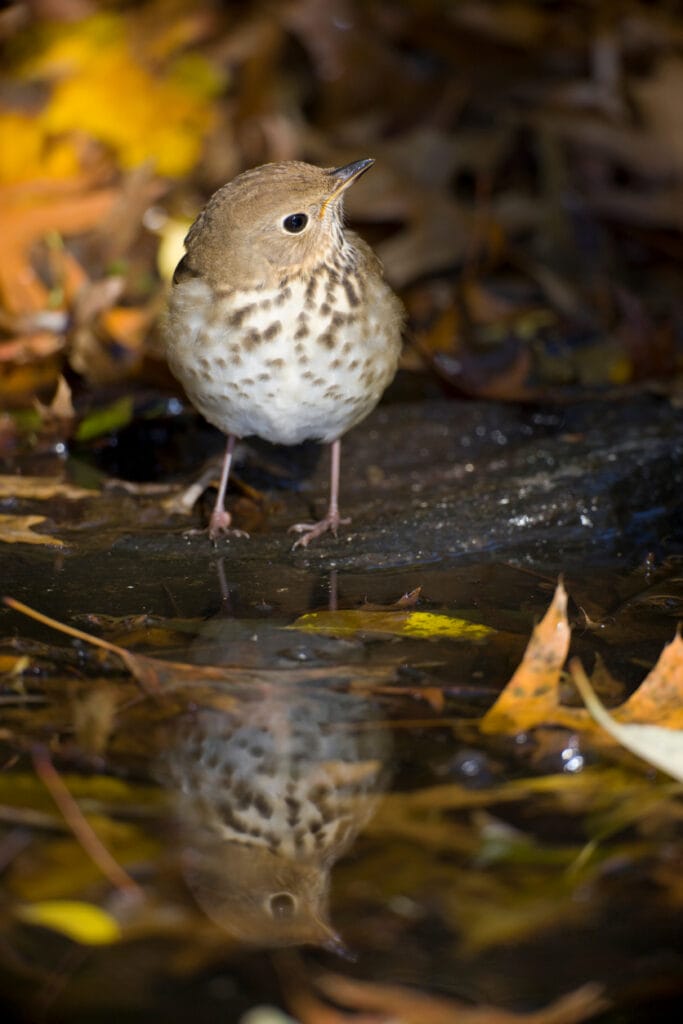
- Scientific name: Catharus guttatus
- Length: 5.5 to 7.1 inches
- Wingspan: 9.8 to 11.4 inches
- Weight: 0.8 to 1.3 ounces
Hermit Thrushes have chunky, compact bodies with a brown upper side and a whitish underside. Their eyes are pitch-black surrounded by a thin light-colored eyering.
When it comes to nesting, these birds like to stay under shrubs or small trees as well as in open areas and forest routes. The female is responsible for building using leaves, grass, mud, and pine needles.
After about a week, the completed nest is around 2 inches deep and 4 to 6 inches wide.
14. Bobolink
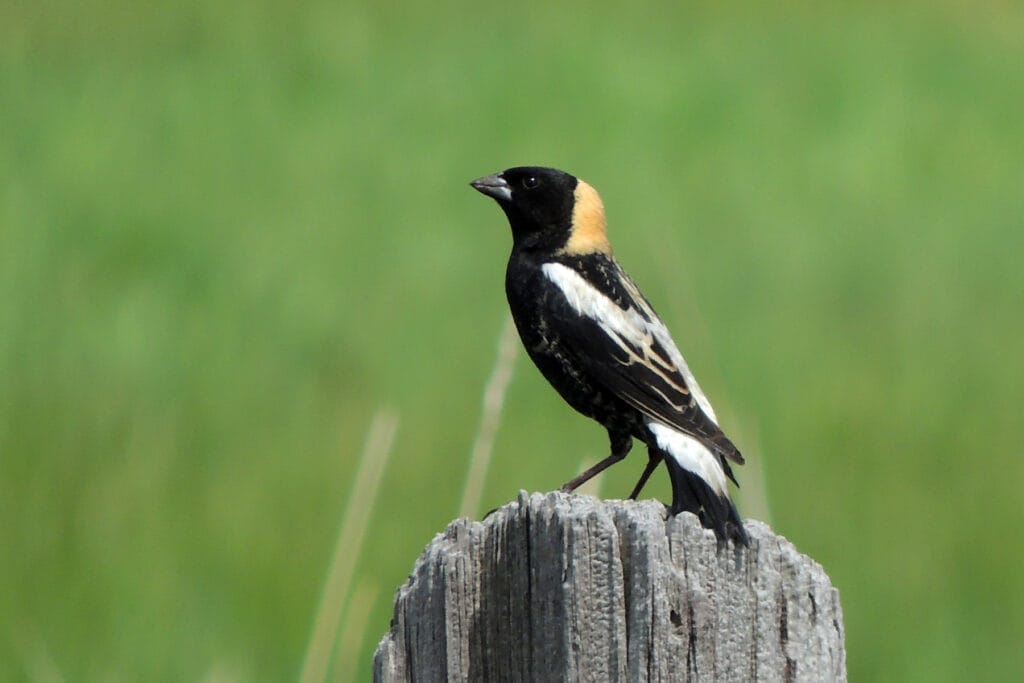
- Scientific name: Dolichonyx oryzivorus
- Length: 5.9 to 8.3 inches
- Wingspan: 10.6 inches
- Weight: 1.0 to 2.0 ounces
The Bobolink is a small songbird that likes to nest on the ground at the base of plants where the soil is wet. The female picks the location within the territory of the male’s territory, then she collects the building materials on her own.
The female uses weed stems and dead plants to make a floorless nest and lines it with fine sedges and grasses directly on the ground. The final result measures about 2 inches deep and 4 to 5 inches wide.
15. Horned Lark
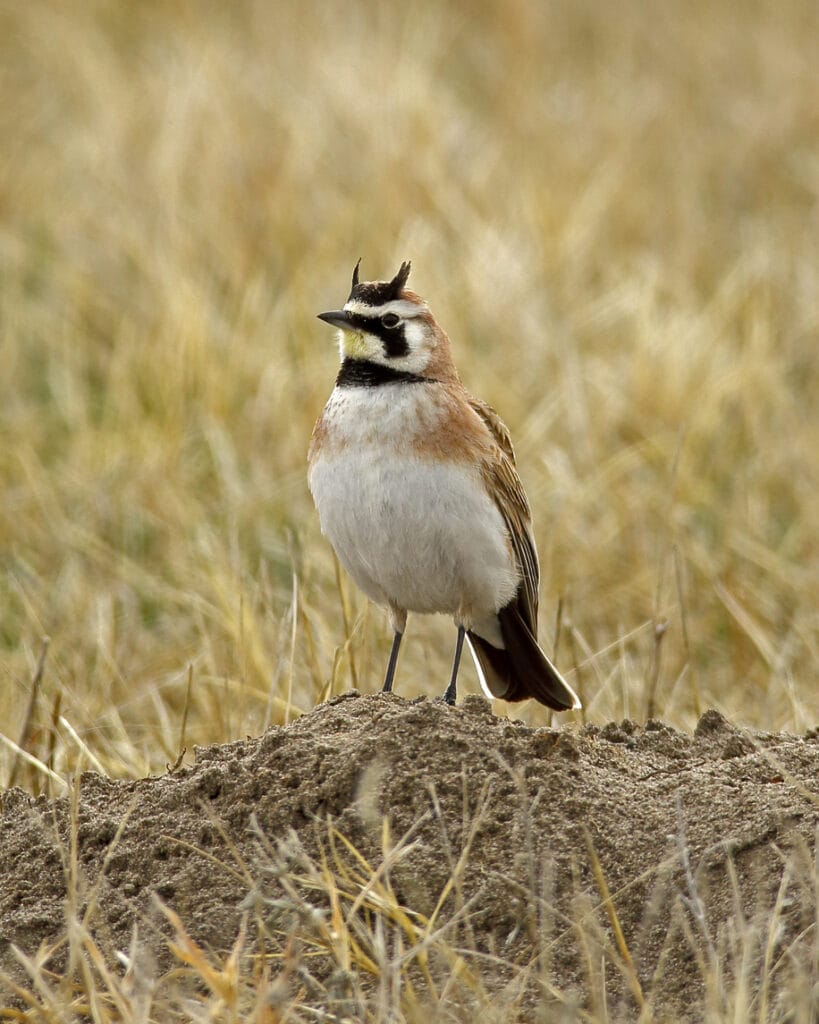
- Scientific name: Eremophila alpestris
- Length: 6.3 to 7.9 inches
- Wingspan: 11.8 to 13.4 inches
- Weight: 1.0 to 1.7 ounces
The Horned Lark gets its name from its head stripes that sometimes stand to look like small horns.
In this species, the female independently chooses the nest location either in a natural dip or a depression that she digs herself. She weaves a nest out of grass and roots, then uses feathers and fur for the lining.
In the end, the nest measures 1.5 inches deep and 3 to 4 inches wide.
Pelagic Birds
Also known as seabirds, pelagic birds spend the vast majority of their lives in the ocean. They include albatrosses, boobies, frigatebirds, and shearwaters.
16. Masked Booby
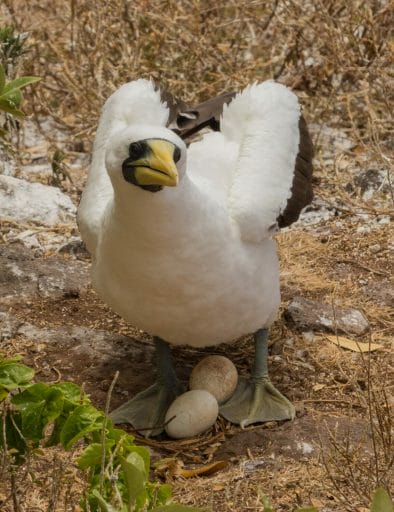
- Scientific name: Sula dactylatra
- Length: 29.1 to 33.9 inches
- Wingspan: 63.0 inches
- Weight: 45.9 to 82.9 ounces
Masked Boobies have white bodies with black feathers on their tails and wings. Their beaks are pale yellow with a black outline at the base that looks like a mask.
Top Tip: These birds build their nests directly on the ground in locations that lack plants.
17. Black-footed Albatross
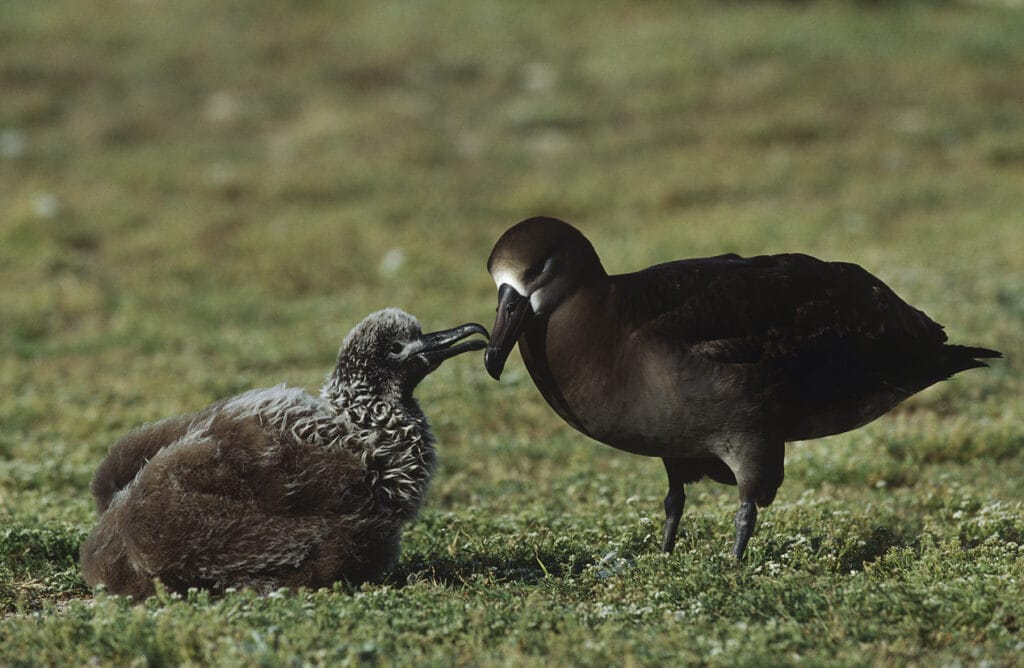
- Scientific name: Phoebastria nigripes
- Length: 25.2 to 29.1 inches
- Wingspan: 76.0-85.0 inches
- Weight: 77.6 to 151.7 ounces
A remarkably large seabird, the Black-footed Albatross has brown plumage with a black beak and feet. It builds its nest on open areas of sand where vegetation is scarce.
Flightless Birds
These are birds that can’t fly, such as:
18. Common Ostrich
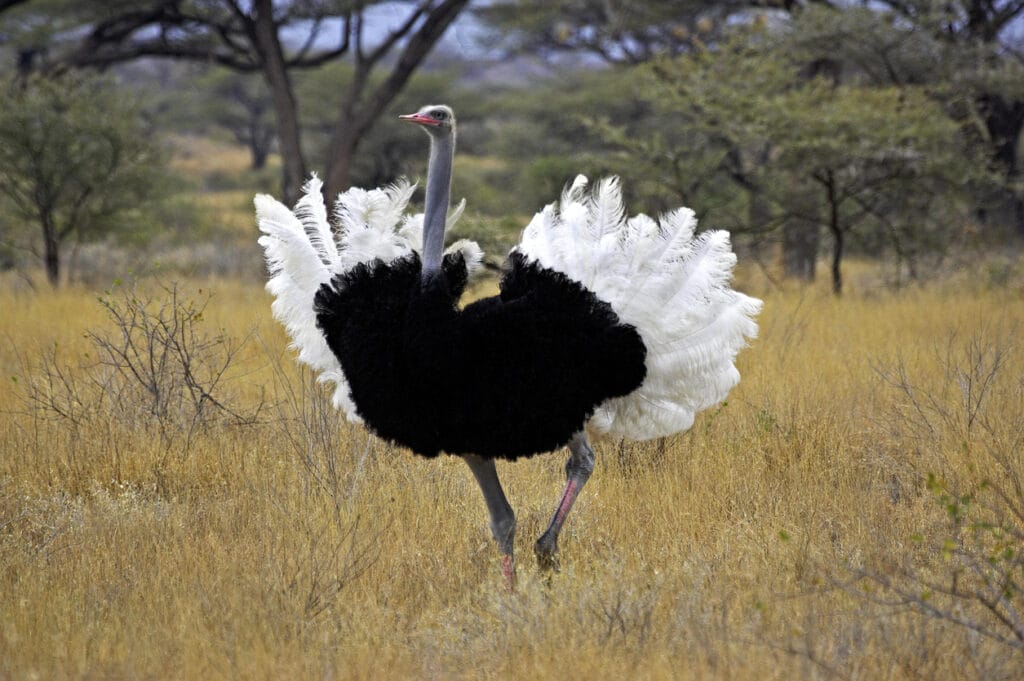
- Scientific name: Struthio camelus
- Height: 6 to 9 feet in males, 5 to 7 feet in females
- Wingspan: 6.5 feet
- Weight: 139 to 320 pounds
In Ostriches, the male ostrich digs multiple holes within its territory then the dominant female walks around and picks the nest that she prefers for laying eggs. An ostrich’s nest can fit around 60 eggs in one go, so several females can share the same nest for their eggs.
19. Common Emu
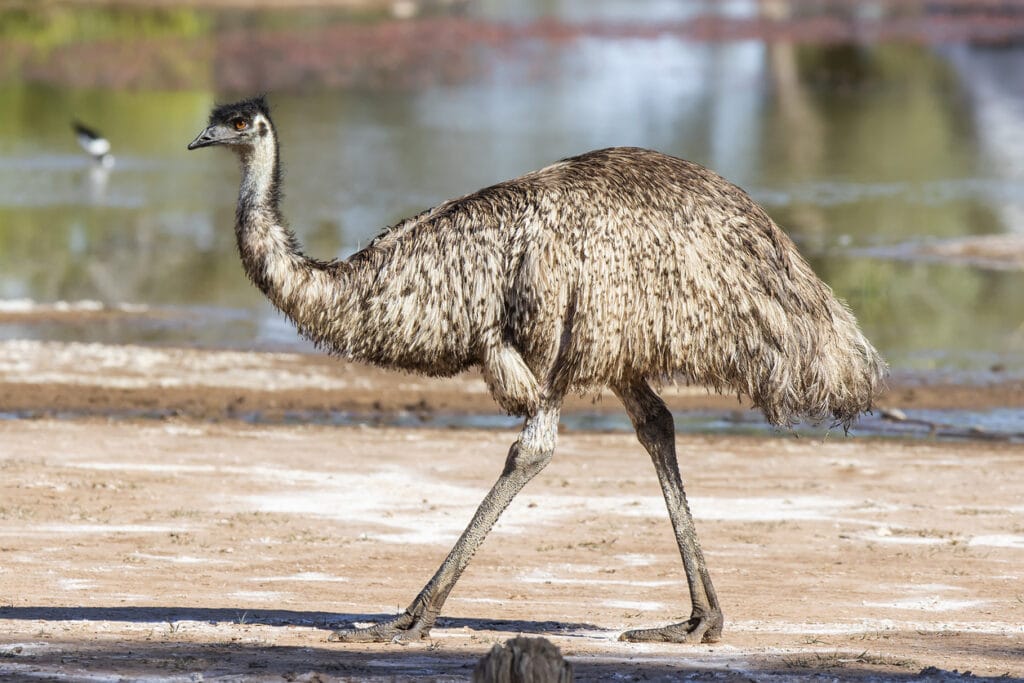
- Scientific name: Dromaius novaehollandiae
- Length: 55 to 65 inches
- Wingspan: 8 inches
- Weight: 66 to 100 pounds
The second-largest living bird after the ostrich, the Common Emu builds its nest out of grass, roots, and other plant materials. When the male finishes the nest, it measures 4 inches deep and 6 to 7 feet wide.
Top Tip: After the female lays the eggs, it’s the male who becomes responsible for incubating and raising the chicks.
Wrap Up
There you have it, 19 species of birds that make nests on the ground. Other than the 7 types of birds we talked about above, additional species of birds that nest on the ground include:
- Owls such as the Burrowing Owl.
- Nightjars such as the Eastern Whip-poor-will.
- Terns such as the Caspian Tern.
- Falcons such as the Peregrine Falcon.
- Loons such as the Pacific Loon.
- Pelicans such as the American White Pelican.
- Bustards.
FAQ
Some do. The most commonly known is the Burrowing Owl. There are also species of seabird, like shearwaters that have burrows on remote islands and cliffs.
Birds like game birds nest on the ground because the cannot get up into trees. Some birds nest on the ground because the location is safe from predators (think cliffs). And some nest on the ground because that is what they have always done like birds in remote countries that had no predators for millions of year.
